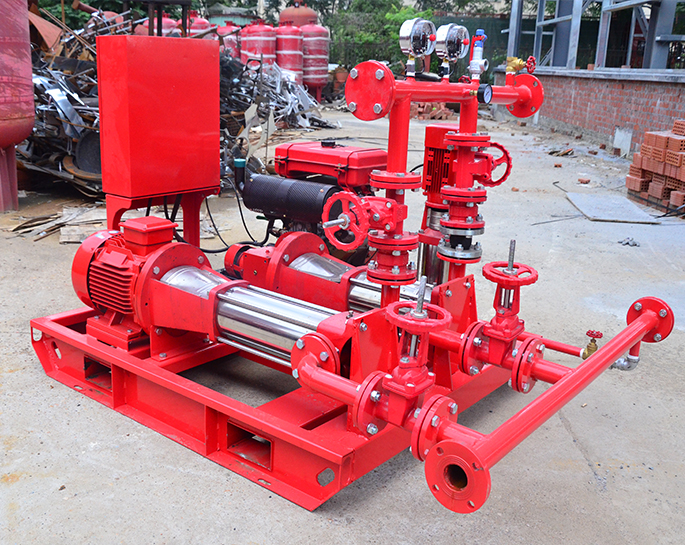What are the emerging trends in fire pump set design and installation?
May 10, 2024
Share:
Several emerging trends are shaping the design and installation of fire pump sets:
1. **Smart Technology Integration**: Fire pump sets are increasingly incorporating smart technology for monitoring, diagnostics, and remote control. IoT sensors, data analytics, and predictive maintenance algorithms enable real-time monitoring of pump performance, early detection of issues, and proactive maintenance scheduling.
2. **Energy Efficiency**: There is a growing focus on energy-efficient design and operation of fire pump sets to reduce operating costs and environmental impact. Variable speed drives, energy-efficient motors, and optimized system designs help minimize energy consumption without compromising performance.
3. **Integration with Building Management Systems (BMS)**: Fire pump sets are being integrated with BMS platforms to provide seamless monitoring and control of fire protection systems alongside other building systems. This integration enhances overall system visibility, control, and coordination, improving response times and efficiency.
4. **Remote Monitoring and Management**: Advances in connectivity and cloud technology enable remote monitoring and management of fire pump sets from anywhere with internet access. This capability allows for proactive maintenance, troubleshooting, and performance optimization without the need for onsite visits, enhancing system reliability and reducing downtime.
5. **Modular and Prefabricated Solutions**: Modular and prefabricated fire pump set solutions are gaining popularity due to their ease of installation, scalability, and flexibility. These solutions streamline the design, procurement, and installation process, reducing project timelines and costs while ensuring consistent quality.
6. **Enhanced Safety Features**: Fire pump sets are incorporating enhanced safety features such as redundant systems, fail-safe mechanisms, and advanced fire suppression technologies to improve reliability and resilience. These features help mitigate the risk of equipment failure and ensure uninterrupted operation during emergencies.
7. **Green and Sustainable Practices**: Sustainable design principles are increasingly being applied to fire pump sets to minimize environmental impact and resource consumption. This includes the use of eco-friendly materials, water-saving technologies, and renewable energy sources where feasible.
8. **Compliance with Standards and Regulations**: With evolving regulations and standards related to fire protection, fire pump set design and installation are focusing more on compliance and adherence to industry best practices. This includes ensuring compatibility with NFPA, UL, and other relevant standards to meet regulatory requirements and ensure system reliability.
By embracing these emerging trends, fire protection professionals can design and install fire pump sets that are more efficient, reliable, and resilient, meeting the evolving needs of modern buildings and facilities.

1. **Smart Technology Integration**: Fire pump sets are increasingly incorporating smart technology for monitoring, diagnostics, and remote control. IoT sensors, data analytics, and predictive maintenance algorithms enable real-time monitoring of pump performance, early detection of issues, and proactive maintenance scheduling.
2. **Energy Efficiency**: There is a growing focus on energy-efficient design and operation of fire pump sets to reduce operating costs and environmental impact. Variable speed drives, energy-efficient motors, and optimized system designs help minimize energy consumption without compromising performance.
3. **Integration with Building Management Systems (BMS)**: Fire pump sets are being integrated with BMS platforms to provide seamless monitoring and control of fire protection systems alongside other building systems. This integration enhances overall system visibility, control, and coordination, improving response times and efficiency.
4. **Remote Monitoring and Management**: Advances in connectivity and cloud technology enable remote monitoring and management of fire pump sets from anywhere with internet access. This capability allows for proactive maintenance, troubleshooting, and performance optimization without the need for onsite visits, enhancing system reliability and reducing downtime.
5. **Modular and Prefabricated Solutions**: Modular and prefabricated fire pump set solutions are gaining popularity due to their ease of installation, scalability, and flexibility. These solutions streamline the design, procurement, and installation process, reducing project timelines and costs while ensuring consistent quality.
6. **Enhanced Safety Features**: Fire pump sets are incorporating enhanced safety features such as redundant systems, fail-safe mechanisms, and advanced fire suppression technologies to improve reliability and resilience. These features help mitigate the risk of equipment failure and ensure uninterrupted operation during emergencies.
7. **Green and Sustainable Practices**: Sustainable design principles are increasingly being applied to fire pump sets to minimize environmental impact and resource consumption. This includes the use of eco-friendly materials, water-saving technologies, and renewable energy sources where feasible.
8. **Compliance with Standards and Regulations**: With evolving regulations and standards related to fire protection, fire pump set design and installation are focusing more on compliance and adherence to industry best practices. This includes ensuring compatibility with NFPA, UL, and other relevant standards to meet regulatory requirements and ensure system reliability.
By embracing these emerging trends, fire protection professionals can design and install fire pump sets that are more efficient, reliable, and resilient, meeting the evolving needs of modern buildings and facilities.







